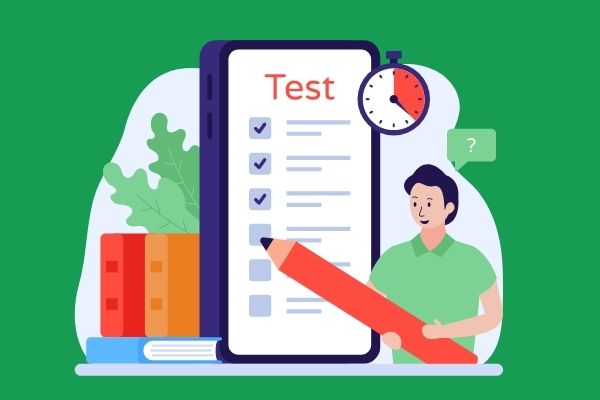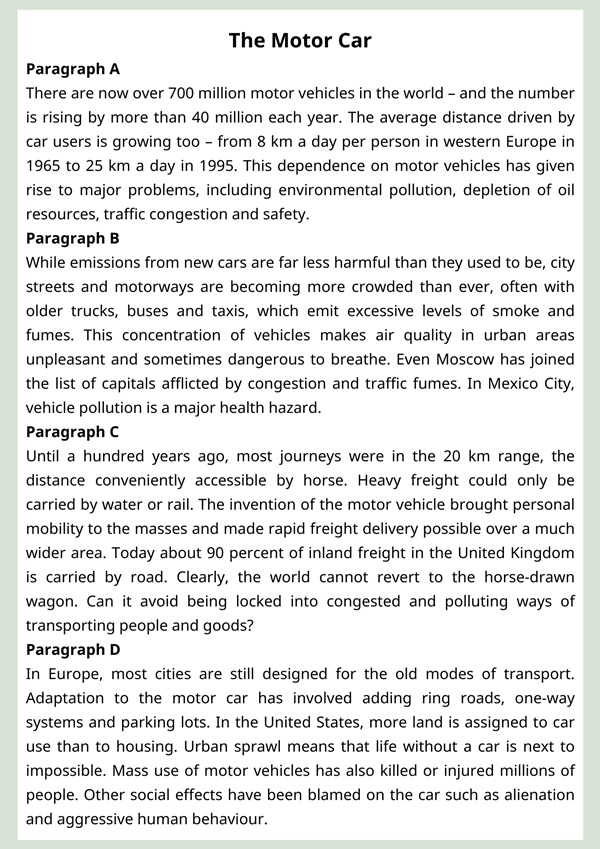



Matching Information IELTS Reading là một trong những dạng bài thường gặp nhất trong bài thi IELTS Reading. Để làm tốt dạng bài này, các bạn thí sinh cần có xử lý thông tin ở các đoạn văn trong thời gian ngắn và đồng thời tìm ra những chi tiết phù hợp trong đoạn.
Đây được đánh giá là dạng bài khó trong các dạng bài Reading IELTS mà các bạn học cần phải nắm chắc các cách làm và thực hành thường xuyên. Trong bài viết này, IELTS LangGo sẽ giải thích, đưa ra những lưu ý, đồng thời chia sẻ các bước làm và tuyệt chiêu giúp chinh phục hiệu quả dạng bài Matching Information IELTS Reading.
Dạng bài Matching Information là dạng bài yêu cầu nối thông tin sao cho lựa chọn được đoạn văn và câu thông tin trùng khớp với nhau. Đây là một dạng bài khó vì chỉ trong một khoảng thời gian khá ngắn, thí sinh sẽ cần phải đọc hiểu và phân tích rất nhiều thông tin.
Cụ thể, trong dạng bài Matching Information IELTS Reading, thí sinh sẽ được cung cấp 3 - 6 statements chứa thông tin. Nhiệm vụ của thí sinh là cần tìm ra những statement này tương ứng với nội dung của đoạn văn nào ở trên.
Thông thường sẽ có những dạng thông tin như sau được trình bày trong câu văn ngắn:
Fact (Sự thật)
Description (Mô tả)
Reason (Lý do)
Definition (Định nghĩa)
Explanation (Giải thích)
Summary (Câu tóm tắt)
Example (Ví dụ)
Những câu hỏi trong dạng bài Matching Information IELTS Reading sẽ kiểm tra và đánh giá được những kỹ năng Skimming and scanning sau của người làm bài thi. Trong đó Skimming (Đọc lướt) để tìm ý tổng quát và Scanning (đọc quét) để tìm các thông tin cụ thể, đọc chi tiết và xác định từ đồng nghĩa cùng cách diễn đạt tương đương.
Để hiểu rõ hơn về dạng bài Matching Information IELTS Reading và nắm được các lưu ý quan trọng, các bạn có thể theo dõi video dưới đây của IELTS LangGo.
Giải mã chi tiết dạng bài Matching Information IELTS Reading (Video)
Trước khi đi vào tìm hiểu chi tiết các bước làm dạng bài Matching information trong IELTS Reading, các bạn hãy cùng IELTS LangGo tham khảo một vài lưu ý quan trọng trước khi làm bài dưới đây để tránh được những hiểu lầm hay sai sót trong quá trình làm bài nhé.

Lưu ý khi làm bài Matching information trong IELTS Reading
Để các bạn hiểu rõ chi tiết các bước làm bài Matching Information IELTS Reading, chúng mình sẽ hướng dẫn cụ thể từng bước dựa trên một đề bài cụ thể. Hãy bắt tay vào làm cùng chúng mình ngay thôi nào.


Dạng bài Matching Information to Paragraphs IELTS

Các statements trong dạng bài Matching Information IELTS Reading
Bước 1: Đọc kỹ các câu thông tin và xác định thông tin, gạch chân từ khóa
Trước khi đọc các đoạn văn, bước đầu tiên bạn cần đọc và xác định được ý chính của các câu thông tin trong đề bài. Sau đó, đừng quên gạch chân những từ khóa quan trọng trong câu và đoán nhanh những từ đồng nghĩa với những từ khóa này.
Có hai dạng từ khóa mà bạn có thể xác định và phân biệt đó là: Từ khóa có thể biến đổi (Changeable keywords) và Từ khóa không thể biến đổi (Unchangeable Keywords).
Từ khóa có thể biến đổi là những từ có thể được thay thế bằng các từ đồng nghĩa khác trong quá trình paraphrase.
Từ khóa không thể biến đổi là những từ sẽ được giữ nguyên trong bất kỳ cách diễn đạt nào ví dụ như tên riêng, số liệu, thời gian,....
Ví dụ ở câu số 14, những từ khóa cần được gạch chân là:
14. a comparison of past and present transportation methods
Những từ khóa trong câu trên đều là những từ khóa có thể biến đổi. Vì vậy, các bạn có thể tìm kiếm và xác định nhanh những từ đồng nghĩa tương ứng với từ khóa đó.
Bước 2: Đọc lướt các đoạn văn
Sau khi nắm được ý chính tại các câu thông tin, bạn cần tiếp tục xác định ý chính trong các đoạn văn. Trong đó, đọc lướt là một chiến lược hiệu quả để tìm ra nội dung chung của đoạn văn nhanh chóng, tiết kiệm thời gian.
Qua đó, các bạn có thể hiểu nội dung từng đoạn trong đề bài đồng thời gạch chân một vài từ/cụm từ khóa quan trọng. Đồng thời, qua đó, bạn có thể loại trừ ngay những đoạn văn chứa nội dung không liên quan với câu thông tin nào và có khả năng không có câu trả lời tương ứng.
Việc làm này có thể giúp bạn tiết kiệm rất nhiều thời gian làm bài.
Bước 3: Đọc lại và tìm đáp án
Sau khi nắm được những thông tin chính của câu hỏi và đoạn văn, bạn có thể đọc lại chúng một lần và thử dò tìm đáp án. Bước làm này phải diễn ra thật nhanh và không nhất định phải có đáp án cụ thể.
Nếu có thể tạm xác định đáp án cho một câu nào đó, bạn có thể đánh dấu chúng lại. Bạn có thể làm câu nào trước cũng được, không cần phải theo đúng thứ tự, miễn là bạn đã tìm ra đáp án và tạm chắc chắn với nó.

Cách làm bài Matching information IELTS Reading
Bước 4: Đọc chi tiết
Đây là bước làm chính, quan trọng và đòi hỏi sự tập trung và mức độ chính xác cao nhất. Sau khi đã tạm xác định được đáp án của một vài câu hỏi và đoạn văn, đây là bước để bạn đọc kỹ lại để kiểm tra các chi tiết và chốt đáp án.
Ta có thể minh họa bằng cách tìm đoạn văn phù hợp và tương ứng với câu 14.
Quan sát đề bài ta thấy, đoạn văn E có chứa các từ khóa khá tương đồng với câu 14 như: transport, car, rail. Hơn thế nữa, đoạn văn này cũng chỉ ra những so sánh về các phương tiện giao thông.
Tuy nhiên, những so sánh tại đoạn E không phải so sánh cụ thể về phương thức vận chuyển trong quá khứ và tương lai mà chỉ so sánh về giá cả khi vận tải bằng ô tô và vận tải bằng đường sắt.
Tiếp theo, hãy cùng phân tích đoạn văn C dưới đây:
C. Until a hundred years ago, most journeys were in the 20km range, the distance conveniently accessible by horse. Heavy freight could only be carried by water or rail. The invention of the motor vehicle brought personal mobility to the masses and made rapid freight delivery possible over a much wider area. In the United Kingdom, about 90 percent of Inland freight is carried by road. The world cannot revert to the horse-drawn wagon. Can It avoid being locked into congested and polluting ways of transporting people and goods?
👉 Tại phần gạch chân, ta nhận thấy, đoạn văn cũng chứa những từ khóa như: a hundred years ago, by horse, by water or rail.
Qua đó, có thể thấy, những từ khóa này chỉ phương tiện vận chuyển và có cả khoảng thời gian đại diện cho quá khứ. Dịch cụ thể như sau:
Cho đến một trăm năm trước, hầu hết các cuộc hành trình đều nằm trong phạm vi 20 km, khoảng cách có thể đi lại thuận tiện bằng ngựa. Hàng hóa nặng chỉ có thể được vận chuyển bằng đường thủy hoặc đường sắt.
Như vậy, đoạn văn này đã thể hiện tính so sánh về phương tiện di chuyển trong quá khứ và hiện tại. Vì vậy, ta có thể kết luận đáp án là 14 - C. ✔️
Sau khi chắc chắn với đáp án của mình, hãy điền chúng vào phiếu trả lời câu hỏi và đồng thời gạch bỏ câu thông tin đó trong đề bài để bạn xác định được đó là câu đã hoàn thành để tránh nhầm lẫn gây mất thời gian làm những câu sau.
Sau khi đã nắm được các bước làm một cách cụ thể, chúng mình sẽ chỉ cho bạn một vài tips hữu hiệu để có thể tận dụng thời gian một cách hiệu quả và làm dạng bài Matching Information IELTS Reading đạt điểm cao nhất có thể nhé.

Tips làm bài Matching Information IELTS Reading
Không quá tập trung vào các ý chính trong đoạn văn
Khác với dạng bài Matching Headings, câu tương ứng để nối với mỗi đoạn văn không hẳn phụ thuộc vào ý chính của nó. Câu thông tin có thể ứng với bất kỳ một nội dung hay chi tiết lớn nhỏ nào thuộc đoạn văn. Vì thế, đừng chỉ đọc lướt mà hãy đọc dò thật chi tiết và kỹ lưỡng để tìm câu trả lời đúng nhất.
Vận dụng từ đồng nghĩa để tìm câu trả lời chính xác
Đây là chiến thuật vô cùng cần thiết và hiệu quả bởi cách diễn đạt trong đoạn văn và câu thông tin sẽ không giống nhau hoàn toàn. Hãy vận dụng vốn từ đồng nghĩa mà mình có để suy luận nghĩa, nội dung các câu để tìm đáp án chính xác.
Vận dụng các từ khóa không thể biến đổi để tìm câu trả lời
Các bạn cũng có thể xác định những từ khóa không thể biến đổi (số liệu, ngày tháng, địa chỉ, tên riêng,...) và vận dụng chúng để tìm ra câu trả lời một cách vô cùng nhanh chóng. Cách này có thể giúp bạn tìm đáp án trong lúc đọc lướt và đồng thời cho kết quả vô cùng chính xác.
Loại trừ những đoạn văn không liên quan
Vì số lượng đoạn văn trong bài thường nhiều hơn số lượng câu thông tin nên sẽ có những đoạn văn không có đáp án tương ứng. Do đó, qua bước đọc lướt để thông tin chính của mỗi đoạn, hãy cố gắng nhanh mắt để loại trừ đi những đoạn văn không liên quan và có khả năng cao không có đáp án.
AUSTRALIA’S SPORTING SUCCESS
A
They play hard, they play often, and they play to win. Australian sports teams win more than their fair share of titles, demolishing rivals with seeming ease. How do they do it? A big part of the secret is an extensive and expensive network of sporting academies underpinned by science and medicine. At the Australian Institute of Sport (AIS), hundreds of youngsters and pros live and train under the eyes of coaches. Another body, the Australian Sports Commission (ASC), finances programmes of excellence in a total of 96 sports for thousands of sportsmen and women. Both provide intensive coaching, training facilities and nutritional advice
B
Inside the academies, science takes centre stage. The AIS employs more than 100 sports scientists and doctors, and collaborates with scores of others in universities and research centres. AIS scientists work across a number of sports, apply skills learned in one -such as building muscle strength in golfers – to others, such as swimming and squash. They are backed up by technicians who design instruments to collect data from athletes. They all focus on one aim: winning. ‘We can’t waste our time looking at ethereal scientific questions that don’t help the coach work with an athlete and improve performance, ‘says Peter Fricker, chief of science at AIS
C
A lot of their work comes down to measurement – everything from the exact angle of a swimmer’s dive to the second-by-second power output of a cyclist. This data is used to wring improvements out of athletes. The focus is on individuals, tweaking performances to squeeze an extra hundredth of a second here, an extra millimetre there. No gain is too slight to bother with. It’s tiny, gradual improvements that add up to world-beating results. To demonstrate how the system worked. Bruce Mason at AIS shows off the prototype of a 3D analysis tool for studying swimmers. A wire-frame model of a champion swimmer slices through the water, her arms moving in slow motion. Looking side-on, Mason measures the distance between strokes. From above, he analyses how her spine swivels. When fully developed, this system will enable him to build a biomechanical profile for coaches to use to help budding swimmers. Mason’s contribution to sport also includes the development of the SWAN (Swimming Analysis) system now used in Australian national competitions. It collects images from digital cameras running at 5- frames a second and breaks down each part of a swimmer’s performance into factors that can be analysed individually – stroke length, stroke frequency, average duration of each stroke, velocity, start, lap and finish times, and so on. At the end of each race. SWAN spits out data on each swimmer
D
‘Take a look’ says Mason, pulling out a sheet of data. He points out the data on the swimmers in second and third place, which shows that the one who finished third actually swam faster. So why did he finish 35 hundredths of a second down? His turn times were 44 hundredths of a second behind the other guy’ says Mason. If he can improve on his turns, he can do much better. ‘This is the kind of accuracy, that AIS scientists’ research is bringing to a range of sports. With the Cooperative Research Centre for Micro Technology in Melbourne, they are developing unobtrusive sensors that will be embedded in an athlete’s clothes or running shoes to monitor heart rate, sweating, heat production or any other factor that might have an impact on an athlete’s ability to run. There’s more to it than simply measuring performance. Fricker gives the example of athletes who may be down with coughs and colds 11 or 12 times a year. After years of experimentation. AIS and the University of Newcastle in New South Wales developed a test that measures how much of the immune-system protein immunoglobulin A is present in athletes’ saliva. If IgA levels suddenly fall below a certain level, training is eased or dropped altogether. Soon, IgA levels start rising again, and the danger passes. Since the tests were introduced.AIS athletes in all sports have been remarkably successful at staying healthy
E
Using data is a complex business. Well before a championship, sport scientists and coaches start to prepare the athlete by developing a ‘competition model’, based on what they expect will be the winning times. ‘You design the model to make that time,’ says Mason. ‘A start of this much, each free-swimming period has to be this fast, with a certain stroke frequency and stroke length, with turns done in these times.’ All the training is then geared towards making the athlete hit those targets, both overall and for each segment of the race. Techniques like these have transformed Australia into arguably the world’s most successful sporting nation
F
Of course, there’s nothing to stop other countries copying – and many have tried. Some years ago, the AIS unveiled coolant – lined jackets for endurance athletes. At the Atlanta Olympic Games in 1996, these sliced as much as two per cent off cyclists’ and rowers’ times. Now everyone uses them. The same has happened to the ‘altitude tent’ developed more than easily the effect of altitude training at sea level. But Australia’s success story is about more than easily copied technological fixes, and up to now no nation has replicated its all-encompassing system
Question 1-7
Reading Passage 1 has six paragraphs, A-F
Which paragraph contains the following information?
Write the correct letter, A-F, in boxes 1-7 on your answer sheet
NB You may use any letter more than once
1 a reference to the exchange of expertise between different sports
2 an explanation of how visual imaging is employed in investigations
3 a reason for narrowing the scope of research activity
4 how some AIS ideas have been reproduced
5 how obstacles to optimum achievement can be investigated
6 an overview of the funded support of athletes
7 how performance requirements are calculated before an event
Nguồn: Cambride ielts 5
1 B
2 C
3 B
4 F
5 D
6 A
7 E
1 Bạn có thể tìm thấy đáp án trong câu’ AIS scientists work across a number of sports, apply skills learned in one -such as building muscle strength in golfers – to others, such as swimming and squash’
2 Bạn có thể tìm thấy đáp án trong câu’ When fully developed, this system will enable him to build a biomechanical profile for coaches to use to help budding swimmers’
3 Bạn có thể tìm thấy đáp án trong câu’ . ‘We can’t waste our time looking at ethereal scientific questions that don’t help the coach work with an athlete and improve performance, ‘says Peter Fricker, chief of science at AIS
4 Bạn có thể tìm thấy đáp án trong câu’ Of course, there’s nothing to stop other countries copying – and many have tried. Some years ago, the AIS unveiled coolant – lined jackets for endurance athletes. At the Atlanta Olympic Games in 1996, these sliced as much as two per cent off cyclists’ and rowers’ times. Now everyone uses them. The same has happened to the ‘altitude tent’ developed more than easily the effect of altitude training at sea level.
5 Bạn có thể tìm thấy đáp án trong câu’ . So why did he finish 35 hundredths of a second down? His turn times were 44 hundredths of a second behind the other guy’ says Mason. If he can improve on his turns, he can do much better’ ; ‘Fricker gives the example of athletes who may be down with coughs and colds 11 or 12 times a year’
6 Bạn có thể tìm thấy đáp án trong câu’ A big part of the secret is an extensive and expensive network of sporting academies underpinned by science and medicine. At the Australian Institute of Sport (AIS), hundreds of youngsters and pros live and train under the eyes of coaches. Another body, the Australian Sports Commission (ASC), finances programmes of excellence in a total of 96 sports for thousands of sportsmen and women. Both provide intensive coaching, training facilities and nutritional advice’
7 Bạn có thể tìm thấy đáp án trong câu’ Using data is a complex business. Well before a championship, sport scientists and coaches start to prepare the athlete by developing a ‘competition model’
Demolish /dɪˈmɒlɪʃ/: phá hủy, đánh đổ
Rival /ˈraɪvl/: kẻ tình định, đối thủ
Underpin /ˌʌndəˈpɪn/: làm nòng cốt cho
Trainning facilities: phương tiện huấn luyện
Nutritional advice: lời khuyên về mặt dinh dưỡng
Back up: sự ủng hộ, hỗ trợ
Instrument /ˈɪnstrəmənt/: phương tiện
Ethereal /ɪˈθɪəriəl/: siêu nhiên
Cyclist /ˈsaɪklɪst/: người đi xe đạp
Wring /rɪŋ/ : vắt, bóp
Prototype /ˈprəʊtətaɪp/: nguyên mẫu
Stroke /strəʊk/cú đánh, quất
Swivel /ˈswɪvl/: khớp khuyên
Velocity /vəˈlɒsəti/: tốc lực
Unobtrusive /ˌʌnəbˈtruːsɪv/: không dễ nhận thấy, kín đáo
Sensor /ˈsensə(r)/: thiết bị báo, bộ báo
Embed /ɪmˈbed/ ăn sâu, bám chặt
Athlete /ˈæθliːt/ vận động viên
Experimentation /ɪkˌsperɪmenˈteɪʃn/: sự thí nghiệm
Immune-system / ɪˈmjuːn sɪstəm/: hệ miễn dịch
Saliva /səˈlaɪvə/: nước dãi, nước bọt
Replica /ˈreplɪkə/: bản sao mô hình thu nhỏ
Mong bài viết hữu ích với bạn trong quá trình ôn luyện IELTS của mình! Chúc bạn học tốt
nguồn: Sưu tầm và tổng hợp
Như vậy, qua bài viết này, IELTS LangGo đã giúp các bạn tìm hiểu chi tiết về các bước làm dạng bài Matching Information IELTS Reading cùng các lưu ý và tips cơ bản. Hy vọng rằng những thông tin mà chúng mình chia sẻ đã giúp ích cho các bạn trong quá trình ôn luyện IELTS.
Các bạn có thể tham khảo thêm chiến thuật làm các dạng bài khác trong IELTS Reading nhé.



ĐẶT LỊCH TƯ VẤN MIỄN PHÍ LỘ TRÌNH Săn ƯU ĐÃI lên tới 12.000.000đ